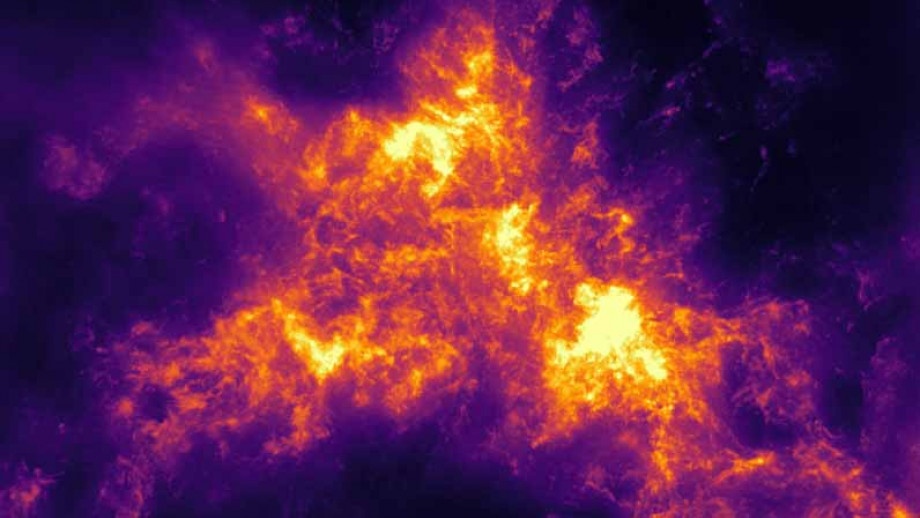The Small Magellanic Cloud (SMC) is over 200,000 light-years away, yet it’s still one of our galaxy’s closest neighbours in space. Ancient astronomers knew of it, and modern astronomers have studied it intensely. But the SMC still holds secrets.
By studying it and revealing its structure in more detail, astronomers at The Australian National University hope to grow our understanding of the SMC and galaxies in general.
A team of astronomers captured the above image with ASKAP—the Australian Square Kilometer Array Pathfinder. By focusing on the hydrogen emitted by the SMC, the image reveals the cloud’s small-scale structure for the first time.
The image is part of a study titled “GASKAP-HI Pilot Survey Science I: ASKAP Zoom Observations of HI Emission in the Small Magellanic Cloud.” The lead author is Dr. Nickolas Pingel, an astronomer at the Australian National University (ANU) Research School of Astronomy and Astrophysics. The study is online at arxiv.org.
“The clarity of this image is unprecedented,” Dr. Pingel said in a press release. “We’re able to see all of the small-scale structures for the first time. It’s an important step in understanding the role hydrogen plays in the evolution of galaxies.”
“For example, you can see holes within the gas. This shows us that hydrogen interacts with supernovae,” Pingel said.
The images in the study are the first images from GASKAP, the Galactic Australian Square Kilometer Array Pathfinder. The study zeroes in on the SMC’s neutral hydrogen (HI) emissions. HI is important because it acts as a tracer for part of the Interstellar Medium (ISM). Overall, the study—and GASKAP—aims to explore the relationships between the ISM and the evolution of galaxies.
Previous studies have examined HI in the Milky Way and the Magellanic Clouds. But they’ve been single-dish studies, and they lacked the power that GASKAP has. GASKAP uses an array of dishes spread over a square kilometre to achieve higher spatial resolution. That higher resolution will allow astronomers to study the small-scale structure of the SMC, the LMC, and the Milky Way.
There’s a lot of interplay between a galaxy and the ISM. The nature of the ISM changes and evolves over time due to things like gas infall, star formation, and stellar feedback. Gas infall is particularly interesting because it can explain the stable level of neutral hydrogen in galaxies even as star formation depletes it. GASKAP should reveal more of the detail in all this interplay.
The study is based on 100 hours of observational data processed in a custom imaging pipeline. The resulting data products are image cubes. Each is a 3901×3471×222 pixel cube that combines GASKAP data with existing data.

As Dr. Pingel points out, this image is the first image from GASKAP’s pilot survey.
“This specific image was part of a pilot survey,” Dr. Pingel said. “Over the next year, we are going to collect more observations. Eventually, we’ll be able to connect them and make a giant mosaic which will show how this galaxy connects to its nearby neighbours.”
Astronomers already know that the Small and Large Magellanic Clouds are connected to each other and the Milky Way. A massive stream of gas called the Magellanic Stream is feeding gas from the Magellanic Clouds’ haloes to the Milky Way, and eventually, our galaxy will likely absorb both the SMC and the LMC. Some of that material is fuelling star formation in the Milky Way.
There’s also a bridge of HI between both of the Clouds named the Magellanic Bridge. A third gaseous feature called the Leading Arm is a diffuse filament of H1 that leads both clouds.

The GASKAP survey promises to expand that knowledge considerably. Astronomers have been studying these gaseous connections but not with the resolution that GASKAP will bring.

This pilot image also shows the different velocities of the Magellanic High-Velocity Clouds (HVC.) HVCs are large clouds of gas found in the galactic halo that make up the Magellanic Stream. The sensitivity of the image, and its higher resolution, allowed astronomers to more tightly constrain the Stream’s kinematics, morphology, and mass. These observations “…in turn trace fundamental properties of the circumgalactic environment around the SMC and Milky Way halo like the total amount of outflowing gas and halo pressure…” the authors say in their paper.

If this pilot image is a reliable indication of what’s to come, then we’re about to learn a lot more about the small-scale structure of the Magellanic Clouds, the Milky Way, and the streams of gas flowing around and between them.
In the paper’s conclusion, the authors write that “The increase in brightness temperature sensitivity, coupled with the unparalleled angular and spectral resolution, ensures the GASKAP-HI survey will provide touchstone data products for the study of HI in the Milky Way and Magellanic System for the next decade and beyond.”

